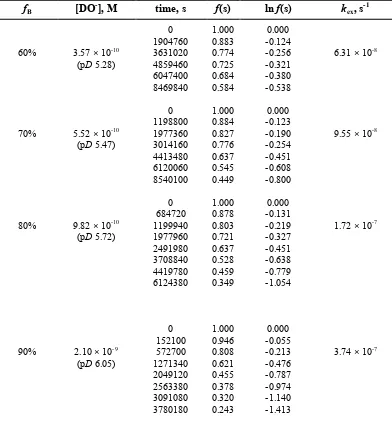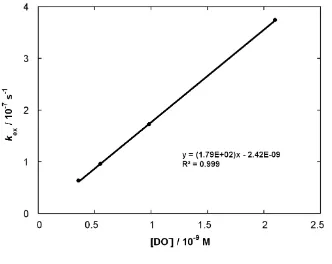Proton Transfer Reactions of a Bridged Bis-propyl Bis-imidazolium Salt
Richard S. Massey,a Peter Quinn,a John A. Murphyb and AnnMarie C. O’Donoghuea,*
aDepartment of Chemistry, Durham University, South Road, Durham DH1 3LE, UK.
bDepartment of Pure and Applied Chemistry, University of Strathclyde, Glasgow G1
1XL, UK
ABSTRACT:
Tetraazafulvalene 1 has found broad application in reduction and other related transformations, and is conveniently generated from bis-propyl bis-imidazolium salt 3 with a strong base in a non-protic solvent. The proposed mechanism for the formation of 1 involves initial deprotonation to give a mono-carbene 9 followed by intramolecular reaction at the second azolium centre. Herein, we report the second order rate constants for deuteroxide-catalyzed exchange of the C(2)-hydrogens of bis -propyl bis-imidazolium di-iodide salt 3 and related monomeric dipropyl imidazolium iodide 10 of kDO = 1.37 × 104 and 1.79 × 102 M-1 s-1, respectively, and used these data to calculate pKa values of 21.2 and 23.1. Formation of tetraazafulvalene 1 was not observed under the aqueous conditions employed highlighting that carbene reprotonation significantly outcompetes dimerisation under these conditions.
INTRODUCTION
Tetraazafulvalenes such as 1 and 2 are a family of neutral electron donors with a strong reduction potential owing to the aromatic nature of the oxidized products. These neutral organic electron donors have been applied in a range of reduction reactions including the reduction of sulfones and sulfonamides,1 and aryl halides to aryl anions2 or aryl radicals.3,4 Donor 1 has also been applied to the formation of aliphatic aldehydes from aliphatic and aryl iodides and alkyl bromides, which has been suggested to go through a one carbon extrusion from the tetraazafulvalene 1.5
-imidazolium salt 3 with potassium hydride in liquid ammonia and also the reduction of biimidazolium salt 4 using sodium metal in liquid ammonia (Scheme 1).6
Thummel reported the electrochemical reduction of biimidazolium 4 to give tetraazafulvalene 1 (Scheme 1).7 Evidence from 13C NMR spectroscopy demonstrated
the presence of a double bond and an X-ray crystal structure gave a C-C bond distance of 1.337 Å.6 Despite the evidence for a C=C double bond, the bond strength
was estimated to be only a few kJ mol-1.6 Recently, Murphy2 reported a convenient,
large scale, method for the preparation of donor 1 from the bis-imidazolium salt 3 (X=I). Using sodium hydride in liquid ammonia, product 1 was obtained in near quantitative yields (Scheme 1).
Scheme 1: Synthetic routes to tetraazafulvalene 1.
[image:3.595.96.506.316.406.2]Calculations of the barriers to dimerisation of a range of monomeric, untethered N-heterocyclic carbenes (NHCs) including 5, 6 and 7 (Figure 1) have been reported and demonstrate the weakness of the C=C bond.8 Alder and co-workers have calculated that the activation barrier for head-to-head dimerisation of two carbenes such as 7 (R=R'=Me) is over 100 kJ mol-1, corresponding to a half-life of ~100 h at a concentration of 1 M in THF.9
Figure 1: NHC structural classes including imidazol-2-ylidene 5, thiazol-2-ylidene 6, imidazolin-2-ylidene 7 and triazol-3-ylidene 8.
reactions is presumed to be the deprotonation of the first imidazolium component 3 followed by reaction of the resulting carbene 9 at the second imidazolium centre (Scheme 2). The tethered bis-propyl linked bis-imidazolium 3 can generate the tetraazafulvalene 1, whereas the analogous butyl linked system only generates the bis carbene.6 The longer tether and weak C=C bond in the latter case favours the carbene
over dimerisation.
Scheme 2: Proposed mechanism of dimerisation of bis-imidazolium salt 3 to give donor 1
As a first key step in the successful generation of bis-linked tetraazafulvalenes involves the initial deprotonation of a bis-bridged bis-imidazolium precursor (e.g. Scheme 2), we were interested in probing the proton transfer properties of bis-linked imidazolium salts in comparison with monomeric analogues. We and others have reported the second order rate constants for deuteroxide-catalysed exchange, kDO (M-1 s-1), and estimates of the aqueous pKa values, of the conjugate acid azolium precursors of a range of NHCs (Figure 1) in aqueous solution, which include imidazol-2-ylidenes 5,11,12 thiazol-2-ylidenes 6,13imidazolin-2-ylidenes 712 and triazol-3-ylidenes
8.14,15 The carbenes thus formed have found many applications as organic catalysts16 and as ligands in organometallic catalysis.17
EXPERIMENTAL
The syntheses of imidazolium salts 3 and 10, the preparation of solutions, the determination of pD and NMR spectroscopic methods are described in the Supporting Information.
Kinetic measurements
The kinetic procedures for the measurement of rate constants for deuterium exchange for imidazolium salts 3 and 10 were identical to those previously reported for the study of analogous imidazolium salts.11,12 Reactions were initiated by the addition of
a solution containing a non-exchanging internal standard (tetramethylammonium deuteriosulfate) and buffer directly to the rigorously dried imidazolium salt. The final substrate and internal standard concentrations in the D2O reaction solutions were 5 mM and 1 mM, respectively. Reaction solutions in NMR tubes were incubated at 25 °C in a thermostatted water bath. pD values were recorded at the beginning and end of each reaction and were found to be constant within error (± 0.05). The progress of the
C(2)-H/D exchange reaction was followed by 1H NMR spectroscopy during the disappearance of 75-90% of the C(2)-H signal of each substrate. There was no change in the integrated areas of signals due to all other protons of imidazolium salts 3 and 10 during this period. The absence of new signals is consistent with the absence of any parallel dimerisation, decomposition or hydrolysis reactions under the reaction conditions.
0 std H -C(2) t std H -C(2) ) / ( ) / ( (s) A A A A
f = (1)
t k f(s) ex
ln =− (2)
Representative NMR spectral overlays of the deuterium exchange reactions, semilogarithmic plots of kex against time, tabulated kex data and second order plots of kex against deuteroxide ion concentration are included in the Supporting Information for imidazolium salts 3 and 10 (Figures S1-S6, Tables S1-S2).
RESULTS AND DISCUSSION
[image:6.595.162.486.443.754.2]Plots of the observed first order rate constants kex against deuteroxide concentration are linear with slopes equivalent to kDO, the second order rate constants for deuteroxide catalysed exchange (Figures S3 and S6). The pD – log rate profiles for 3 and 10 shown in Figure 2 have unit slopes consistent with a first order dependence of kex values on deuteroxide concentration.
Figure 2: pD – log rate profiles for the deuterium exchange reactions of the C(2)-hydrogen(s) of doubly linked bis-imidazolium salt 3 (●) and dipropyl imidazolium salt 10 (■) in D2O at
25 °C and I = 1.0 M (KCl).
-7.5 -7 -6.5 -6 -5.5 -5 -4.5
4 4.5 5 5.5 6 6.5
The C(2)-H/D deuterium exchange reactions of imidazolium salts 3 and 10 were performed in aqueous acetic acid buffer solutions at a range of pD values and at constant ionic strength, I = 1.0 M (KCl). Deuterium exchange at pDs > 7 or < 4 was too fast or slow, respectively, for convenient analysis using our NMR spectroscopic procedures. Buffer catalysis of deuterium exchange was found to be insignificant in all previous studies of azolium ion conjugate acids of N-heterocyclic carbenes including representative imidazolium salts.11,12 Hence, it was assumed that buffer
catalysis of exchange was not significant and the observed pseudo first order rate constants for exchange, kex (s-1), for reactions performed in acetic acid buffers were used directly in second order plots of deuterium exchange.
Scheme 3: Deuteroxide ion-catalysed C(2)-H/D exchange in D2O solution.
A mechanism for specific base-catalysed deuterium exchange for general azolium ion 11 is shown in Scheme 3. Deprotonation of azolium species 11 by deuteroxide ion yields an intimately bound complex of carbene/ylide 12 and a molecule of HOD (k1).11,12 This step is reversible, and transfer of the proton back to the carbene/ylide
may regenerate the azolium ion (k-1). Alternatively, solvent reorganisation will result in complex 13·DOL (L = H or D), where the DOL molecule is positioned to deliver a deuteron to the carbene (kreorg). Deuteration to form the exchanged product 14 is essentially irreversible as under these conditions bulk solvent D2O is present in large excess relative to substrate (10 mM). As discussed previously,11,12,14 evidence
the rate constant for solvent reorganisation by the Principle of Microscopic Reversibility (kreorg = kHOH = 1011 s-1).
[image:8.595.85.510.313.685.2]The kinetic acidities of imidazolium salts 3 and 10 towards deuteroxide ion at 25 °C and I = 1.0 M (KCl) are presented in Table 1, alongside literature data for related imidazolium salts included for discussion. Also shown in Table 1 are krel values, where kDO values for salts 3 and 15 – 18 are compared to the value of 1,3-dipropylimidazolium salt 10.
Table 1 Kinetic acidities (kDO) and estimates of C2-H pKas of structurally related mono-
and bis-imidazolium salts determined at 25 °C and I = 1.0 (KCl)
Substrate kDOa/M-1 s-1 krelb pKac Ref.
15 2.47 × 102 1.35 23.0 11
16 2.29 × 102 1.25 23.0 12
10 1.83 × 102 1.0 23.1 this work
17 2.98 × 105 1. 63 × 103 19.9 12
18 1.30 × 103 7.10 22.3 12
3 1.37 × 104 74.9 21.2 this work
Estimation of Carbon Acid pKas
The carbon acid pKa values of imidazolium salts 3 and 10 may be obtained using Eqn (3) which is derived from Scheme 4, where kHO (M-1 s-1) is the second order rate constant for deprotonation by hydroxide and kHOH (s-1) is the rate constant for the reverse protonation of the carbene by solvent water. The second-order rate constants for deuteroxide ion-catalysed exchange, kDO (M-1 s-1), may be used to obtain rate constants for deprotonation by hydroxide ion, kHO (M-1 s-1), using the secondary solvent isotope relationship kDO/kHO = 2.4.20 As discussed earlier, there is good evidence that the rate constant for carbene protonation by water, kHOH (s-1), is limited by dielectric relaxation of solvent and may be equated to kreorg = 1011 s-1.21 By combining values of kHO and kHOH in Eqn (3), carbon acid pKa values may be estimated for 3 and 10 and these results are summarised in Table 1.
Scheme 4: Equilibrium for deprotonation by hydroxide of imidazolium ions 3 and 10 at C(2).
⎟⎟ ⎠ ⎞ ⎜⎜ ⎝ ⎛ + =
HO HOH W
a p log
p
k k K
K (3)
Substituent and Tethering Effects on Acidity
The kinetic acidities (kDO) and associated aqueous pKa values for a series of N-methyl, N-alkyl imidazolium ions have been reported, and show that the linear N-alkyl chain length does not substantially affect C(2)-H acidities.12 The value of kDO determined in
the present study for 10 is within 35% of the reported values for similarly substituted 1,3-dimethylimidazolium iodide 15 by Amyes,11 and 1-ethyl-3-methylimidazolium
chloride 16 by O’Donoghue,12 and consistent with these conclusions. Accordingly,
N-alkyl substituents have a larger influence on acidity in both water and DMSO. For example, placing t-butyl or adamantyl groups on both nitrogens causes a significantly larger increase in pKa of 2.2 and 2.5 units, respectively, compared to 1,3-dimethylimidazolium salt 15.12
Comparing the kDO value for monomeric 1,3-dipropylimidazolium salt 10 with singly linked bis-imidazolium salt 1812, and considering the very small n-alkyl substituent
effects discussed above, allows the 7.1-fold increase for 18 in this case to be attributed to the effect of a second imidazolium substituent. In principle, the formation of an intramolecular hydrogen bond as in 19 could perhaps favour carbene formation, and result in an increased kDO value, if a linear C-H---:C hydrogen bond could be achieved. However, a substantially larger krel = 1.63× 103 was observed for methylene linked bis-imidazolium salt 17 more consistent with an inductive or electrostatic origin to this observed substituent effect as a linear hydrogen bond would be difficult to attain in this case. The presence of a cationic second imidazolium substituent will result in the inductive or electrostatic destabilisation of the dicationic azolium ion relative to the monocationic carbene, however, this effect will diminish as the distance between the two imidazolium moieties increases (cf. 17vs18).
there is a net increase in kDO relative to both 10 and 18. However, the inductive or electrostatic benefit of bis-tethering in 3 does not outweigh that obtained via a shorter methylene linker in 17.
The C(2)-H pKa data for the imidazolium salts in Table 1 follows the trend 17 < 3 < 18 < 10 ~ 16 ~ 15. As just discussed, this may be rationalized in terms of small n -alkyl substituent effects and the proximity of the second imidazolium unit to the first, with an increase in pKa observed as distance between the imidazolium rings increases. In terms of absolute pKas, the value for doubly bridged bis-propyl bis-imidazolium salt 3 is similar to those for diaryl imidazolium salts 2012 and larger than the more acidic triazolium (21)14,15 and thiazolium (22)13 salts. Thus the acidifying effect of
bis-tethering two imidazoliums using a propyl linker is similar to those observed upon replacing two N-alkyl by N-aryl substituents in a single imidazolium unit, however, is smaller than the effect of new or additional NHC heteroatoms as in 21 and 22.
Implications for Dimerisation
formation of such fulvalenes in protic solvents is also disfavoured in competition with the particularly fast proton transfers observed in NHC systems. Unlike many carbon acids e.g. α-carbonyl acids, proton transfer to and from NHCs such as 5 – 8 is typically involves low intrinsic barriers.11, 24
Scheme 5: Competition between H/D exchange and dimerisation reactions.
CONCLUSIONS
The H/D-exchange reaction of a doubly propyl bridged bis-imidazolium salt 3 was studied in comparison with monomeric analogue 10. A 75-fold decrease in kinetic acidity is observed for the unbridged dipropylimidazolium iodide 10 compared to the doubly propyl bridged bis-imidazolium salt 3.This may be attributed to the inductive or electrostatic electron withdrawing effect of an additional imidazolium substituent in the bridged system. Based on the absence of dimer 1, we may conclude that in aqueous solution, dimerisation occurs with a rate constant significantly smaller than for NHC protonation by solvent water (kdimer << 1011 s-1).
ACKNOWLEDGEMENTS
REFERENCES
1 F. Schoenebeck, J. A. Murphy, S. Zhou, Y. Uenoyama, Y. Miclo and T. Tuttle, J. Am. Chem. Soc., 2007, 129, 13368.
2 J. A. Murphy, S. Zhou, D. W. Thomson, F. Schoenebeck, M. Mahesh, S. R. Park, T. Tuttle and L. E. A. Berlouis, Angew. Chem. Int. Ed., 2007, 46, 5178 3 J. A. Murphy, T. A. Khan, S. Zhou, D. W. Thomson and M. Mahesh, Angew.
Chem. Int. Ed., 2005, 44, 1356.
4 E. Doni and J. A. Murphy, Chem. Commun., 2014, 50, 6073.
5 J. A. Murphy, F. Schoenebeck, N. J. Findlay, D. W. Thomson, S. Zhou and J. Garnier, J. Am. Chem. Soc., 2009, 131, 6475.
6 T. A. Taton and P. Chen, Angew. Chem. Int. Ed., 1996, 35, 1011.
7 Z. Shi, V. Goulle and R. P. Thummel, Tetrahedron Lett., 1996, 37, 2357. 8 L. Nyulászi, T. Veszprémi and A. Forró, Phys. Chem. Chem. Phys., 2000, 2,
3127.
9 R. W. Alder, M. E. Blake, L. Chaker, J. N. Harvey, F. Paolini and J. Schütz, Angew. Chem. Int. Ed., 2004, 42, 5896.
10 Y.-T. Chen and F. Jordan, J. Org. Chem., 1991, 56, 5029.
11 T. L. Amyes, S. T. Diver, J. P. Richard, F. M. Rivas and K. Toth, J. Am. Chem. Soc., 2004,126, 4366.
12 E. M. Higgins, J. A. Sherwood, A. G. Lindsay, J. Armstrong, R. S. Massey, R. W. Alder and A. C. O’Donoghue, Chem. Commun., 2011, 47, 1559.
13 M. W. Washabaugh and W. P. Jencks, Biochemistry, 1988, 27, 5044.
14 R. S. Massey, C. J. Collett, A. G. Lindsay, A. D. Smith, A. C. O’Donoghue, J. Am. Chem. Soc. 2012, 134, 20421.
15 D. E. Tucker, P. Quinn, R. S. Massey, C. J. Collett, D. J. Jasiewicz, C. R. Bramley, A. D. Smith and A. C. O’Donoghue, J. Phys. Org. Chem., 2015, 28, 108.
16 (a) D. Enders, O. Niemeier and A. Henseler, Chem. Rev., 2007, 107, 5606; (b) N. Marion, S. Diez-Gonzalez and I. P. Nolan, Angew. Chem. Int. Ed., 2007, 46, 2988; (c) D. M. Flanigan, F. Romanov-Michailidis, N. A. White and T. Rovis, Chem. Rev., 2015, 115, 9307; (d) D. Bourissou, O. Guerret, F. P. Gabbai and G. Bertrand, Chem. Rev., 2000, 100, 39; (e) X. Bugaut and F. Glorius, Chem. Soc. Rev., 2012, 41, 3511; (f) A. T. Biju, N. Kuhl and F. Glorius, Acc. Chem. Res., 2011, 44, 1182.
17 (a) S. Díez-González, N. Marion and S. P. Nolan, Chem. Rev., 2009, 109, 3612; (b) O. Kühl, Chem. Soc. Rev., 2007, 36, 592; (c) R. H. Grubbs, Tetrahedron, 2004, 60, 7117; (d) M. C. Perry and K. Burgess, Tetrahedron: Asymmetry, 2003, 14, 951; (e) W. A. Hermann, Angew. Chem. Int. Ed., 2002, 41, 1290.
18 J. Peon, R. Pottel and A. Schumacher, J. Phys. Chem., 1992, 96, 6017. 20 V. Gold and S. Grist, J. Chem. Soc., Perkin Trans. 2, 1972, 89.
21 (a) U. Kaatze, J. Chem. Eng. Data 1989, 34, 37; (b) U. Kaatze, R. Pottel, A. Schumacher, J. Phys. Chem. 1992, 96, 6017.
22 Y. Chu, H. Deng and J.-P. Cheng, J. Org. Chem., 2007, 72, 7790.
Supporting information
Proton Transfer Reactions of a Bridged Bis-propyl Bis-imidazolium Salt
Richard S. Massey,a Peter Quinn,a John A. Murphyb and AnnMarie C. O’Donoghuea,*
aDepartment of Chemistry, Durham University, South Road, Durham DH1 3LE, UK.
bDepartment of Pure and Applied Chemistry, University of Strathclyde, Glasgow G1 1XL,
UK
Table of Contents
General Information S2
Synthesis of Substrates S3
Kinetic Experimental Details S4
Deuteroxide Exhange Reactions in Water S5
General Instrumentation
NMR samples were prepared in deuterated chloroform, deuterium oxide and d6-dimethyl sulfoxide (DMSO). NMR spectra were recorded on Bruker Ultrashield 400 MHz and Oxford AS500 500 MHz spectrometers. 1H and 13C NMR chemical shifts in CDCl
3 are reported
relative to CHCl3 at 7.27 ppm and 77.0 ppm respectively. In D2O, 1H NMR chemical shifts are reported relative to HOD at 4.67 ppm. In CD3CN, 1H and 13C NMR chemical shifts are reported relative to CHD2CN at 1.94 ppm for 1H and 1.3 and 118.3 ppm for 13C NMR.
Infrared spectra were recorded on a Perkin-Elmer Spectrum RX-1 FT-IR spectrometer as KBr discs or thin films between NaCl plates.
Melting points were determined using a Gallenkamp MPD 350-BM3.5 melting point
apparatus and are uncorrected.
Analytical thin layer chromatography (tlc) was carried out on pre-coated 0.20 mm
Machery-Nagel Polygram SIL G/UV254 silica plates. Visualization was carried out by absorption of ultraviolet light.
Materials All chemicals used were reagent grade, purchased from Sigma Aldrich and were
Synthesis of Substrates
…(3)
1,3-Dipropylimidazolium iodide (10)
Based on a procedure by Thieuleux and co-workers,S1 a mixture of sodium hydride (6.11 g, 41 mmol) and imidazole (1.0 g, 15 mmol) in dry THF (30 mL) was stirred for 20 min at r.t. under an inert atmosphere. 1-Iodopropane (3.0 mL, 31 mmol) was added dropwise and the solution refluxed for 48 h. The solution was filtered and the precipitate washed with THF. The filtrate was evaporated under reduced pressure, and the residue dissolved in dichloromethane (30 mL) and filtered. The solution was washed with pentane (4 × 30 mL) and solvent removed under reduced pressure to yield the title compound as a brown oil (2.67 g, 64%), with spectroscopic details in accordance with the literature. 1H NMR (700 MHz, CDCl3): δH 1.01 (6H, t, J=7.4 Hz, 2 × CH3), 2.00 (2H, m, 2 × CH2), 4.34 (4H, t, J=7.3 Hz, 2
Kinetic Details
Measurement of pD in D2O solutions
Calibration: The pH values of buffered solutions were determined at 25 ºC using a MeterLabTM PHM 290 pH-Stat Controller equipped with a radiometer (pH 4 - 7 @ 25 °C) combination electrode, that could be standardised between pH 4 - 7 to encompass the pH of the buffer solution.
Determination of [DO–]: The pD (± 0.03) was calculated by adding 0.4 to the observed reading of the pH meter in the D2O solution.S2 The deuteroxide concentration (M) was calculated using Eqn (S1):
[DO–] = (10pD – pKw)/γ
DO (S1)
where Kw = 10-14.87
M is the ionic product of D2OS3 at 25 ºC and γDO is the apparent activity
coefficient of deuteroxide ion under our experimental conditions. The apparent activity coefficient of deuteroxide ion, γDO = 0.73, was determined from the measured pH of solutions of known [HO–] in water at I = 1.0 (KCl) and 25 °C, with the assumption that γDO = γHO. For these measurements, the pH apparatus was standardized at 7.00 and at 12.47 with calcium hydroxide solution that was saturated at 21 °C.S3 pD values were recorded at the beginning and end of reaction, and were found to be constant (± 0.05).
NMR Parameters
1H NMR spectra of imidazolium salts 3 and 10 were recorded on either Bruker Ultrashield
Deuterium Exchange Reactions in D2O Solution
For each imidazolium salt 3 and 10 the following data are included: a representative 1H NMR overlay of deuterium exchange at one pD value, a semi-logarithmic plot of f (s) as a function of time for all pDs and a second order plot of kex values against deuteroxide concentration.
Bridged bis-propyl bis-imidazolium diiodide (3)
Pseudo-first-order rate constants for the deuteroxide ion-catalysed exchange of the two C(2)-H groups of imidazolium salt 3 to form di-deuterated product 3’’ were determined by 1H NMR spectroscopy (400 MHz).
Figure S1: Representative 1H NMR spectra at 400 MHz of imidazolium salt (3) (10 mM, pD
5.46), obtained during exchange of the C(2)-H (s, 8.99 ppm) for deuterium in D2O at 25 ºC and I
= 1.0 (KCl) [Internal standard, tetramethylammonium deuteriosulfate (s, 3.24 ppm)]
[image:19.595.89.508.139.463.2]Experimentally observed first-order rate constants for exchange, kex (s-1), were determined from the slopes of semi-logarithmic plots of f(s) against time at each pD. Reaction data and values of kex are presented in Table S1 and Figure S2.
Table S1: Reaction data and first-order rate constants for exchange of the two C(2)-H groups of imidazalium salt (3) for deuterium in solutions of acetic acid buffer (250 mM) in D2O at 25 ºC
and I = 1.0 (KCl).
fB [DO-], M time, s f(s) ln f(s) kex, s-1
10% 2.17 × 10-11
(pD 4.07)
0 11100 77760 250200 353400 422400 702060
1.000 0.977 0.971 0.915 0.879 0.855 0.783
0.000 -0.023 -0.030 -0.089 -0.128 -0.156 -0.245
3.40 × 10-7
t = 0 1329 min 2803 min
[image:19.595.98.496.657.763.2]30%
50%
70%
90%
9.05 × 10-11 (pD 4.69)
2.17 × 10-10 (pD 5.07)
5.33 × 10-10
(pD 5.46)
2.07 × 10-9
(pD 6.05)
0 80940 172620 352740 421740 701760 884520 1129080 0 19140 80520 169200 352380 421020 535860 701100 0 10440 41220 79740 101640 168180 192900 258900 0 10140 19320 30780 43080 81420 1.000 0.907 0.807 0.650 0.595 0.412 0.334 0.241 1.000 0.938 0.776 0.600 0.333 0.273 0.190 0.121 1.000 0.928 0.747 0.557 0.468 0.283 0.232 0.145 1.000 0.746 0.570 0.405 0.292 0.098 0.000 -0.098 -0.214 -0.431 -0.519 -0.887 -1.095 -1.425 0.000 -0.064 -0.253 -0.511 -1.101 -1.298 -1.658 -2.116 0.000 -0.075 -0.292 -0.585 -0.758 -1.261 -1.459 -1.930 0.000 -0.293 -0.562 -0.903 -1.231 -2.320
1.26 × 10-6
3.05 × 10-6
7.52 × 10-6
2.84 × 10-5
(a) Concentration of deuteroxide ion calculated using Equation S1. (b) Fraction of substrate remaining f(s) calculated using Eqn (1) (main paper). (c) Pseudo-first-order rate constant for exchange, kex (s-1), obtained from
Figure S2: Semilogarithmic plots of the fraction of unexchanged substrate against time for the deuterium exchange reaction of (3) in solutions of acetic acid buffer (250 mM) in D2O at 25 ºC
and I = 1.0 (KCl).
Figure S3: Plot of kex against [DO–] for the H/D-exchange reaction of imidazolium salt (3) in
D2O at 25 ºC and I = 1.0 (KCl)
1,3-Dipropylimidazolium iodide (10)
Pseudo-first-order rate constants for the deuteroxide ion-catalysed exchange of the C(2)-H of imidazolium salt 10 to form deuterated product 10’ were obtained by 1H NMR spectroscopy (400 MHz).
respectively, and the signal corresponding to the CH3 group appears as a triplet at 0.91 ppm. No change was observed in the integrated area of any other peak relative to the internal standard, indicating that deuterium exchange does not occur at any position other than at C(2)-H under these conditions.
Figure S4: Representative 1H NMR spectra at 400 MHz of imidazolium salt (10) (10 mM, pD
6.05), obtained during exchange of the C(2)-H (s, 8.81 ppm) for deuterium in D2O at 25 ºC and I
= 1.0 (KCl) [Internal standard, tetramethylammonium deuteriosulfate (s, 3.20 ppm)]
Experimentally observed first-order rate constants for exchange, kex (s-1), were determined from the slopes of semi-logarithmic plots of f(s) against time at each pD. Reaction data and values of kex are presented in Table S2 and Figure S5.
t = 0 33819 min 64148 min
Table S2: Reaction data and first-order rate constants for exchange of the C(2)-H of imidazolium salt (10) for deuterium in solutions of acetic acid buffer (250 mM) in D2O at 25 ºC
and I = 1.0 (KCl).
fB [DO-], M time, s f(s) ln f(s) kex, s-1
60%
70%
80%
90%
3.57 × 10-10
(pD 5.28)
5.52 × 10-10
(pD 5.47)
9.82 × 10-10
(pD 5.72)
2.10 × 10-9
(pD 6.05)
0 1904760 3631020 4859460 6047400 8469840 0 1198800 1977360 3014160 4413480 6120060 8540100 0 684720 1199940 1977960 2491980 3708840 4419780 6124380 0 152100 572700 1271340 2049120 2563380 3091080 3780180 1.000 0.883 0.774 0.725 0.684 0.584 1.000 0.884 0.827 0.776 0.637 0.545 0.449 1.000 0.878 0.803 0.721 0.637 0.528 0.459 0.349 1.000 0.946 0.808 0.621 0.455 0.378 0.320 0.243 0.000 -0.124 -0.256 -0.321 -0.380 -0.538 0.000 -0.123 -0.190 -0.254 -0.451 -0.608 -0.800 0.000 -0.131 -0.219 -0.327 -0.451 -0.638 -0.779 -1.054 0.000 -0.055 -0.213 -0.476 -0.787 -0.974 -1.140 -1.413
6.31 × 10-8
9.55 × 10-8
1.72 × 10-7
3.74 × 10-7
(a) Concentration of deuteroxide ion calculated using Equation S1. (b) Fraction of substrate remaining f(s) calculated using Eqn (1) (main paper). (c) Pseudo-first-order rate constant for exchange, kex (s-1), obtained from
[image:24.595.102.494.126.551.2]Figure S5: Semilogarithmic plots of the fraction of unexchanged substrate against time for the deuterium exchange reaction of (10) in solutions of acetic acid buffer (250 mM) in D2O at 25 ºC
and I = 1.0 (KCl).
A value of 1.79 × 102 M-1 s-1 for the second-order rate constant for deuteroxide ion-catalysed exchange, kDO, was obtained from the slope of a plot of kex against deuteroxide ion concentration (Figure S6).
Figure S6: Plot of kex against [DO–] for the H/D-exchange reaction of imidazolium salt (10) in
[image:25.595.129.461.511.775.2]References
S1 M. Bouhrara, E. Jeanneau, L. Veyre, C. Copéret and C. Thieuleux, Dalton Trans., 2011, 40, 2995.
S2 P. K. Glasoe and F. A. Long, J. Phys. Chem., 1960, 64, 188.

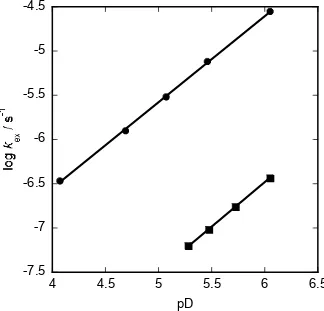
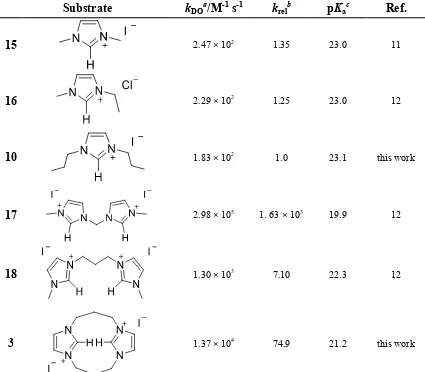
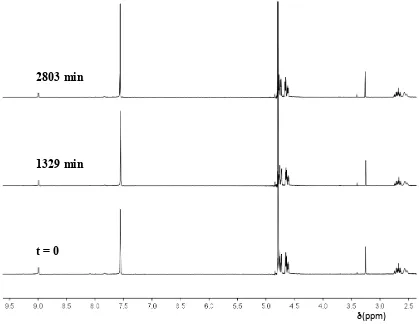
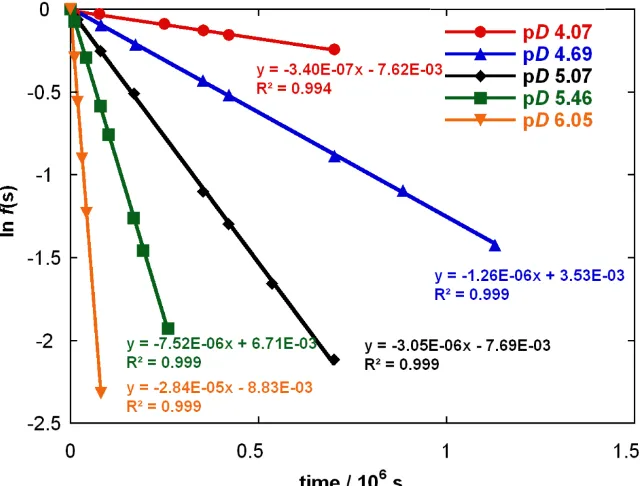
![Figure S3: Plot of kex against [DO–] for the H/D-exchange reaction of imidazolium salt (3) in](https://thumb-us.123doks.com/thumbv2/123dok_us/1541670.106704/22.595.121.459.127.526/figure-s-plot-kex-exchange-reaction-imidazolium-salt.webp)
![Figure S4: Representative 1H NMR spectra at 400 MHz of imidazolium salt (10) (10 mM, pD 6.05), obtained during exchange of the C(2)-H (s, 8.81 ppm) for deuterium in D2O at 25 ºC and I = 1.0 (KCl) [Internal standard, tetramethylammonium deuteriosulfate (s, 3.20 ppm)]](https://thumb-us.123doks.com/thumbv2/123dok_us/1541670.106704/23.595.86.509.244.563/representative-imidazolium-obtained-deuterium-internal-standard-tetramethylammonium-deuteriosulfate.webp)
